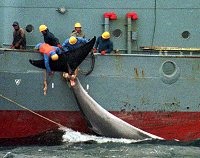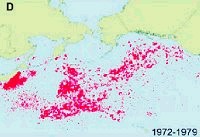|
Crashes in seal, sea lion and sea otter populations in some parts of the world may have occurred because intense commercial whaling forced killer whales to turn to new prey for food, a new U.S. study suggests.
Dr Alan Springer of the University of Alaska Fairbanks and colleagues report their findings in today's issue of the Proceedings of the National Academy of Sciences.
The abrupt decline of smaller marine mammals in the North Pacific Ocean and Bering Sea in recent decades has to date been thought to be due to "bottom-up" changes in the food chain, perhaps due to climate change or competition with human fisheries. According to Springer and colleagues, however, the evidence suggests otherwise.
"The current weight of evidence is more consistent with top-down forcing," their report says. "Increased predation by killer whales probably drove the sea otter collapse and may have been responsible for the earlier pinniped [seal and sea lion] declines as well.
"We propose that decimation of the great whales by post-World War II industrial whaling caused the great whales' foremost natural predators, killer whales, to begin feeding more intensively on the smaller marine mammals, thus 'fishing-down' this element of the marine food web."
Reported whale harvests in the
North Pacific Ocean and Bering Sea
from 1972 to 1979 (PNAS)
The researchers concede that their theory is speculative, but say the evidence is persuasive. For example, they argue, survivors of one particular population of Steller sea lions are not badly nourished and have abundant food. Meanwhile, other studies have shown that predation by killer whales accounts for the bulk of the crash in sea otter numbers, and this may well be a key but largely overlooked reason behind the losses in the other species as well.
Not all killer whales specialise in eating marine mammals, but those that do are known to attack and eat all species of the great whales: it's now thought, for example, that many whale species that migrate long distances to warmer waters to give birth do so to avoid exposing their vulnerable newborns to killer whales.
Computer modelling suggests that only a small proportion of killer whales in the study area - perhaps as few as 7% - would need to shift from eating whales to other mammals to cause the observed population crashes.
Complex ecological chain reaction
Springer and colleagues report that the timing of the declines in seal and sea otter numbers is consistent with killer whales losing the great whales as a major food source then turning their attentions to other species one by one.
Seal declines in the Aleutian Islands in the 1980s, for example, were followed by a crash in sea-otter numbers in the 1990s. The loss of sea otters in turn allowed one of their food sources, sea urchins, to undergo a population explosion and overgraze kelp forest ecosystems, which in turn suffered a collapse.
"Many ecosystems function in vastly different ways today than they did when large animals were common, and there is no reason to believe the open sea is an exception," say the researchers.
"If our hypothesis is correct, either wholly or in significant part, commercial whaling in the North Pacific Ocean set off one of the longest and most complex ecological chain reactions ever described, beginning in the open ocean 50 years ago and leading to altered interactions between sea urchins and kelp on shallow coastal reefs."
Interestingly, killer whales themselves may be headed for a crash since they are long-lived animals. When great whales were abundant, killer whale numbers would have been proportionately high. But, suggest the authors, seals and otters, being smaller and less nourishing, cannot sustain so many large predators.
Industrial whaling was global in scope and any ecosystem-level effects are likely to have occurred elsewhere in the world oceans as well: "A greater appreciation of this fact is needed to properly understand the function of the oceans, now and in the past," the researchers conclude.
Related Stories
Gene study blows whaling out of the water, News in Science 25th July 2003
Seals can tell friend from foe, News in Science 14th November 2002
Top
|

